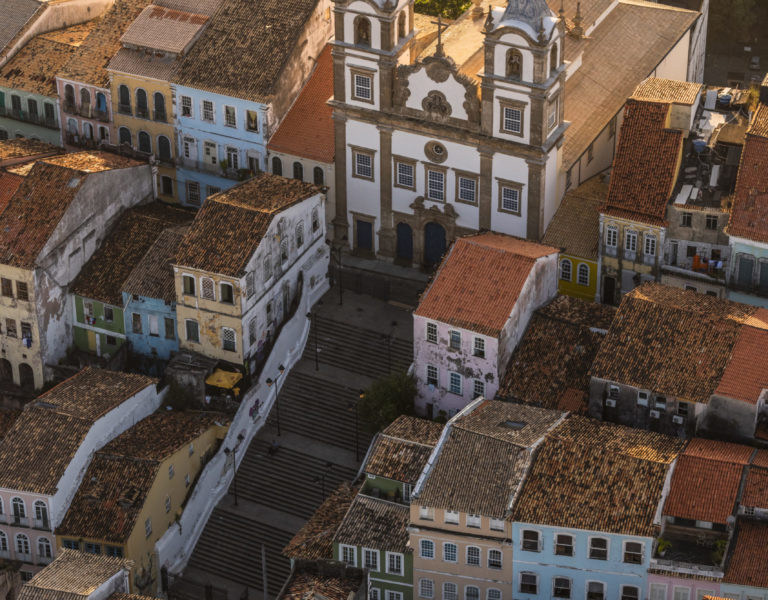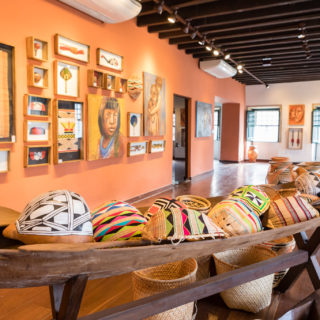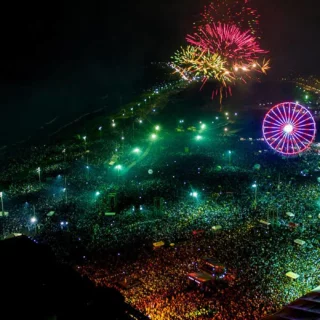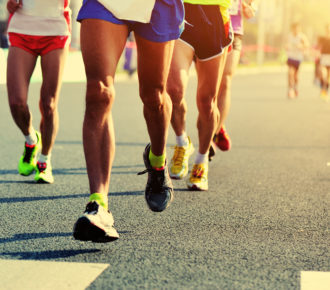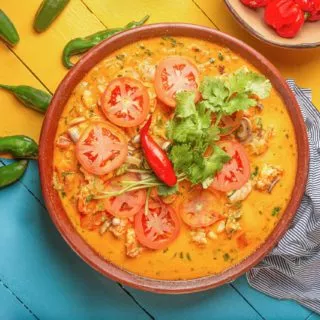
City Hall starts live broadcasts marathon to strengthen tourism in Salvador
Live itineraries, a new format to attract visitors from Bahia and Brazil
Imagine being at home and still being able to walk around Salvador. This virtual tour, in addition to beautiful images, also includes good conversations with tour guides, historians and a presenter who will tell you curiosities and give tips on the most diverse locations in the first capital of Brazil. This is the idea of the Live Tour, a series of live broadcasts to make you want to walk around the city as soon as possible. Some of the places that are on the itinerary are Bonfim, Itapuã, Barra and Rio Vermelho. You will also visit the Memorial Irmã Dulce, Pelourinho, beaches and go to one of the islands in the suburb of the city.
The Live Tour is a project by the city of Salvador, through the Municipal Department of Culture and Tourism (Secult), to strengthen internal tourism. The initiative is in partnership with the Brazilian Association of Travel Agencies (Abav) and will feature live broadcasting of 11 editions. The opening program will take place next Sunday (13th), at 10 am, at Praça Municipal, and will be presented by one of the biggest names in Bahian journalism and a great connoisseur of the city: José Raimundo.
The live broadcast will be featured through Visit Salvador da Bahia’s Facebook, Instagram and YouTube profiles, directly from the locations established by the agencies’ scripts. Internet users will be able to follow this virtual visit, interact through the profile of social networks and have their questions and comments answered in real time on the broadcast. You better keep this unmissable program saved in this link
Understand everything, don’t miss anything!!!!
The programs will always have a tourist guide, registered with the Ministry of Tourism (MTur), a historian and a presenter, showing options for routes and tourist attractions in the city. The itineraries to be presented were suggested by reception agencies affiliated with Abav and are curated by Secult.
The public who follow the program will be able to enjoy the experiences of the capital of Salvador for an hour, with broadcasts twice a week – on Tuesdays and Fridays, at 4 pm – always from a different place, with tours and tourist attractions in the city, contemplating the sun and beach, history and culture, gastronomy and nautical sports segments. All the programs will be available on Visit Salvador da Bahia’s Instagram and YouTube for those who cannot follow at the moment and want to watch later.
In addition, the portal salvadordabahia.com is supporting the project, through a platform that will have hot sites of reception agencies participating in the programs. In this way, the Internet user who is watching will be able to obtain more information about the experiences and tourist itineraries presented and contact the reception agency to purchase their trip to Salvador.
Week by week schedule
Historic Center – Praça Municipal (Municipal Square)
The opening broadcast of the Live Tour Salvador project took place on June 13, the Tourist Day, directly from Praça Municipal. The program was conducted by journalist José Raimundo and shown live. The presenter had a chat with Louti Bahia, urban planner and publicist responsible for the “I love Salvador’s History” social media profile.
With the Rio Branco Palace and the Lacerda Elevator in the background, during the conversation we saw images of Mercado Modelo, Baía de Todos-os-Santos and many other points of the city. Louti Bahia told several curiosities about the capital, including a little about the history of the headquarters of the country’s general government, located in Praça Municipal, the construction of the city walls and its ruins still standing, the emergence of Fort São Marcelo and a little of the history of customs and the city’s port, which, until the 19th century, was the largest port in South America. The public also had the opportunity to interact live with questions to the participants.
Watch this link.
Date: up the 15th
Can you imagine taking a bike tour through Itapuã?
On the second Live Tour you will take a bike ride and learn about other stories from the neighborhood of Itapuã. Watch the episodes every Tuesday and Friday, always at 4 pm, on the official networks of Visit Salvador da Bahia: Instagram, Facebook and Youtube.
Are you coming?
YouTube: https://lnkd.in/d3MTYbE
Instagram: https://lnkd.in/dzhmjna
Facebook: https://fb.me/e/UCq1i1R2
Under the command of the presenter José Raimundo, the first visit is in the neighborhood of Itapuã and the participants are historian Murilo Mello, reporter Pablo Vasconcelos and tour guides Pedro Neto, from the Voyage agency, and Moisés Pinheiro, from the agency Turisbike.
The tour begins on the Itapuã Cycle Path, towards the Lighthouse, through some important points in the neighborhood, such as the Mermaid, Itapuã Lighthouse, Rua da Música (formerly Rua K) and the surroundings, where several iconic artists of our culture, like Vinícius de Moraes and Juca Chaves, lived.
There, we learn about the history of the Lighthouse and the curiosities about the name Itapuã. The beauties of the coast and water sports are also highlights. We take a walk around Praça de Vinicius de Moraes and end up at Casa de Vina, Vinicius’ last address, which houses a memorial full of the artist’s personal objects and a restaurant.
Historian Murilo Mello, author of the Instagram profile @Murilomellohistória, presents a timeline of the neighborhood, starting with the etymology of the name Itapuã and going through several other striking factors. Not everyone knows, but the neighborhood was once a land grant and the scene of an indigenous revolt.
Mello also talks about some factors that attracted residents to the region, each one in its own time. Some of these factors were whale fishing, which boosted the local economy for a period, and the construction of the aerodrome in Santo Amaro de Ipitanga and Avenida Octávio Mangabeira, which made access to the neighborhood easier.
But the housing boom took place in the 1970s, with the construction of Avenida Luís Viana Filho (Paralela). Those who watch the live broadcast will also have more information about the cultural and religious richness of the neighborhood, with the “Ganhadeiras de Itapuã”, the church, music and Afro groups, among other cultural and religious manifestations.
Watch the episode on this link.
Salvador Beach Clubs
The third episode of the Live Tour Salvador project walks now through the beach clubs in Salvador, with a special focus on the “cabanas” (beach huts with restaurant structure) of Lôro and Pipa, at Praia do Flamengo. The virtual tour here was planned by the agencies Grou Turismo and Luck Receptivo.
Let’s go to HCT – Experience the Surf Life, which works in an ultra-modern headquarters, at Praia do Flamengo, where the best waves in the city are found, a perfect place for surf lovers. In its structure, various training sessions are offered, which are part of the routine of professional athletes seeking the highest performance of their abilities. In addition to sports activities, the space also has stores inspired by sports.
From there, we go to the Beach Club Lôro Flamengo, a real oasis by the sea, with massage therapy, children’s area, wi-fi, showers and a lounge. Great structure to receive families with children and also offers access to a beautiful beach! Let’s talk to Aluísio Melo, known as Lôro, founder of the most famous beach club network in Bahia.
To finish the tour, we go to Pipa, the perfect place to enjoy the beach in a stylish way. Located on a large plot of land with a coconut grove by the sea, Pipa has a beachy and cozy atmosphere, as well as a great restaurant where drinks, typical food and other items of local and international cuisine are served. The proposal is to guarantee that the visitor will experience the sea in Salvador, combined with all the comfort and infrastructure of environments usually found outside the sand strip.
Watch the episode on this link.
Come for a walk in Rio Vermelho
The place where the Caramuru shipwreck occurred, home to artists such as Jorge Amado and Zélia Gattai, the Rio Vermelho neighborhood is the next point to be unveiled by Live Tour Salvador. The presenter José Raimundo and the anchor Felipe Velozo receive professor Jorge Amado Neto, the tour guide from Tatur, Lívia Pereira and the tour guide from Cassi, Mateus Vidal, who, in addition to being a guide, is a musician from Olodum.
The tour, full of art, poetry and bohemian life, begins at Casa do Rio Vermelho, at 33 Rua Alagoinhas, where the public will visit the story of the couple Jorge and Zélia, with many memories and curiosities of the writers. From there, the tour continues at Largo de Santana, where you will learn about the history of the church, Casa de Iemanjá, Iemanjá Festivity and Vila Caramuru (former Mercado do Peixe). Afterwards, we continue on a bike ride along the shore, passing the Odoyá sculpture by Ray Vianna, until we arrive at La Taperia restaurant, ending with good food, a chat about the Bloco Afro Olodum and much more.
Memories
At his grandparents’ house, Jorge Amado Neto is responsible for receiving Zé Raimundo to start the tour of the neighborhood. For him, the expectation is to be able to present to the Bahians a little more of their grandparents’ intimacy.
“People have the idea of a museum as something that will present Jorge and Zélia as public figures, like the people everyone knows. In the live broadcasting, we tell a little about the intimacy, which is the proposal of the house, the place where they wrote, the clothes they wore, the environments they frequented, what they did. So, we show a couple closer to people, which is a different view.”
Watch the episode on this link.
Come and visit the Sanctuary of Saint Dulce
The location is one of the main points in the city’s religious tourism itineraries
The Live Tour Salvador arrives at Cidade Baixa (Lower City) and presents the Sister Dulce Memorial. Presenter José Raimundo and reporter Felipe Velozo receive tour guides Eli Antônia (Vitofap Tur) and Val Novaes (Aval Turismo), in addition to Ronaldo Castro, who works at the Saint’s Memorial in Salvador.
In the live broadcast, the theme revolves around the Catholic faith and the most important thing that visitors and devotees of Saint Dulce of the Poor can find there, which is the beginning of the Caminho da Fé (Faith Path) that goes to the Basilica of Nosso Senhor do Bonfim.
After a complete tour of the Memorial, the live program goes to the Church of Saint Dulce of the Poor and the Relic Room, where the saint’s body is located. Father Manoel Filho, national coordinator of the Pastoral do Turismo, was invited to tell everything about Catholic religious tourism.
“Religious tourism is growing in Salvador and the fact that we have a saint from Bahia changes everything. More and more, there are curious and devoted people wanting to know the memorial and the history of Saint Dulce of the Poor”, says Eli Antônia, who has been working as a tour guide in this region of the city for 12 years.
With 33 years of experience in Bahian tourism, mostly in the religious sector, Val Novaes highlights the importance of people getting to know more about this side of the Bahian capital, which is far from that vision of a beach town, focused only on entertainment.
“Religious tourism is already part of the itinerary of most agencies in Salvador, because a recurring request from people who come to the city is: ‘Shall we stop by the Sister Dulce memorial?’ This itinerary becomes touristic from the moment we visit the sanctuary, the church of Santo Antônio, the Sister Dulce Social Works, the café and the souvenir shop, telling the whole story of this wonderful woman”, she explains.
Ronaldo Castro is used to talking about Sister Dulce every day as he has been working on the memorial for over a decade and considers this continuous return to the theme important, as a way to keep alive the memory and representativeness of Saint Dulce for Bahia and for the world.
“She changed from being the saint of only Bahians to reach believers from all over the country and even around the world. Then you stop and think that she is someone in our midst, who has lived with us for many years. Even though I wasn’t here in her time, I feel part of it today,” he says.
Watch the episode on this link.
The beauties of Bonfim
In this live broadcast, Soteropolitans and tourists will visit the Lower City virtually and discover the beauties of Colina Sagrada (Holy Hill), learn more about the Church of Bonfim and then go to Ponta de Humaitá.
This is the fifth edition of Live Tour Salvador, which has journalist José Raimundo as presenter and anchor Felipe Velozo. This episode has the participation of guests who will show you a little more about the religious tourism of Salvador, such as the tour guide Cleber Batista, from TCH Viagens e Turismo; the creator of the Vila Criativa Project, Simone Costa; the rector of the religious temple, Father Edson Menezes; the historian, Murilo Mello and the tour guide Nivaldo Cerqueira, from RNB Turismo. Come and discover the religiosity of Bonfim!
Colina Sagrada
Every year, on the second Thursday of January, thousands of Bahians and tourists dress in white, occupy the streets of Salvador and follow in procession from the Basilica of Nossa Senhora da Conceição da Praia, in Comércio, to the Basilica of Senhor do Bonfim, on Colina Sagrada. It is about eight kilometers of walk and demonstration of faith.
The Colina Sagrada, apex of the Bonfim Festivity, where the stairs and churchyard are washed, was the starting point of the Live Tour Salvador. At the opening, presenter José Raimundo interviewed the tourist guide Cleber Batista, from TCH Viagens e Turismo, who told a little about the strength of local religiosity, the curiosities of the rituals and the enchantment of visitors.
“This place has an inexplicable energy. It’s a point that shouldn’t be missed. I’ve brought a lot of people who have made a promise to a family member and when they got here they were so moved that they couldn’t even speak. So, the Colina Sagrada has a unique enchantment that only those who come can feel.”
The beginning of Lavagem do Bonfim dates back to the second half of the 18th century, as the historian Murilo Mello has shown. But faith in Senhor do Bonfim is not restricted to the celebration on the second Thursday of the year. It is also present on the church’s railing, where locals and tourists tie little ribbons of Senhor do Bonfim and make three wishes; on going to the holy place, dressed in white; on the last Friday of the year, to give thanks for the graces achieved; and on the first Friday of the year, to ask for protection.
From the external region of the basilica, the Live Tour Salvador departed for the interior of Casa da Colina, located near the church, from where the presenter Felipe Veloso exhibited the attractions of Vila Criativa, including the sale of religious items, the gastronomy and handicrafts of the place, which functioned as a shelter for pilgrims.
The basilica
The energy of the Senhor do Bonfim Sanctuary Basilica was one of the highlights presented by the rector of the religious temple, Father Edson Menezes.
“For us who experience everyday life here at Bonfim church, who see the manifestations of people’s faith and experience the mystique of this place, it is very enjoyable to share, communicate and talk about its meaning in the city of Salvador and the good things this place represents to this city, especially at a time like this one of pandemics and sad news. It’s good to talk about what’s good and the Church of Bonfim is a place of good.”
This fifth edition of Live Tour Salvador also explored the Rubens Freire de Carvalho museum, better known as the Ex-Votos Museum, where people usually leave gifts in thankfulness, and the beautiful view from the Bonfim tower. The program ended at Ponta de Humaitá, where the only fort in the city that has a part inside the sea is located and from where it is possible to watch one of the most beautiful sunsets in the city.
“This region of the Lower City is of great historical importance for Salvador. The Lavagem and Church of Bonfim are part of the identity and memory of Bahia. They are symbols of our memory and identity and are of fundamental importance for our recognition as Bahians”, said historian Murilo Mello.
The history of Salvador begins here
In this historic tour, we will pass by Rua Chile, the first street in Brazil, by Praça Castro Alves, Praça Tomé de Souza and incredible buildings. Come and discover the birthplace of Salvador’s history! Come to the Live Tour Salvador!
Set in a stretch of Salvador’s historic center, from Praça Castro Alves to Sé, the Live Tour Salvador begins with a conversation between journalist José Raimundo and city researcher Louti Bahia, postgraduate in Urban Development and responsible for “Amo a História de Salvador” (I love the History of Salvador) page on Instagram.
You will find out about the Monument of the Poet Castro Alves, walk along Rua Chile – the first street in Brazil, learn more about the Cine Glauber Rocha and the Barroquinha Cultural Center, as well as remember the old carnivals, when the trios with Moraes Moreira and Caetano Veloso used to meet.
Afterwards, journalist Luana Souza talks with tour guides Moema Brochini (Mavir Turismo) and Luciene de Castro (LR Tour). First, Luana goes to the top of the Fasano Hotel, from where the conversation becomes more interesting with the All Saints Bay as a backdrop. In another moment, she takes you to the Elevador Lacerda to have a coconut “maltado” and look at the view from above. The tour also passes by the Misericórdia Museum and Praça da Cruz Caída.
“Tourists have access to what Bahia, especially Salvador, has to offer, such as its history, culture, beaches and gastronomy. The guides are ambassadors of the city, we open Salvador’s doors to the world, through an oral and dynamic version of the history of the first capital of Brazil”, comments guide Moema.
Journalist José Raimundo takes you to the Fera Palace Hotel, from the bar on the ground floor to the terrace where there is a copper dome. The conversation revolves around the architecture of the place and the view, with a stunning sunset. Afterwards, he takes a tour of the Archbishop’s Palace of Salvador, at Praça da Sé, and ends the live tour telling more about this space little known by residents and visitors.
The guide Luciene de Castro talks about the current profile of tourists: “I work with tourists, mostly, who accept the historical content, but want something more dynamic and modern, the current flavor of the city in gastronomy, in new architectural projects, in fine arts, music and the busiest beaches. They are also attentive to what is new in relation to the manifestations, especially those of African-based religions”, she explains.
The charms of the Historic Center
The heart of Salvador beats here, in the Historic Center. On this tour, you will get to know one of the most famous sights in the city and have access to tips and incredible beauty. Come and see!
The true Soteropolitan has already tried “cravinho” in Terreiro de Jesus. If before the pandemic the place was the stage for large parties, in the early 1550s the square began the urban expansion of the Bahian capital. With immense historical, cultural and gastronomic wealth, the area, located in the Historic Center, is the theme of the seventh edition of Live Tour Salvador.
In this edition, the virtual itinerary presented by journalist José Raimundo has the participation of tour guides Fábio Gondim and Lázaro Marrom, in addition to bringing explanations by historian Roberto Pessoa.
“Terreiro de Jesus is the embryo of a great capital. The first urban expansion took place in the region, with the arrival of the Catholic order. Therefore, it is a cradle of Afro, Portuguese and indigenous cultures”, said the historian.
The tour begins with a flight over the trade region, passing by the Gonçalves Inclined Plane, until arriving at Casa do Carnaval. There, journalist José Raimundo takes the guided tour, learning everything about the biggest popular street party in the world. Afterwards, he walks to the Cathedral Basilica of Salvador, where he meets Deacon Raimundo Moreno.
The tour covers the arrival of the Jesuit priests in Brazil, the construction of the first college and the chapel, which today is the Cathedral.
At Terreiro de Jesus, journalist Luana Souza talks about how many affectionate memories she keeps from that place and also about the first medical school in Brazil, where the Afro-Brazilian Museum of UFBA (Mafro) is now located. Then, she passes by the O Cravinho bar. Afterwards, she returns from inside the most emblematic salon of Pelourinho with Negra Jho, one of the biggest references in braids and turbans in Bahia.
“Tourists who arrive at Terreiro de Jesus are fascinated by the beauty, but the historical context leaves people in awe. Viewers will be able to go deep in this story” promises guide Lázaro Marrom. “The variety of options that the square offers, in terms of entertainment and gastronomic culture will also be presented”, he said.
Journalist José Raimundo returns straight from Largo do Cruzeiro in São Francisco and enters the Gold Church: the Church and Convent of São Francisco. After showing the altar and unraveling the stories of the place, José Raimundo goes to Le Glacier Laport ice cream parlor, where the live tour ends talking about the diversity of flavors and, of course, enjoying an ice cream sitting at one of the tables in the charming external area.
Everyone loves the Historic Center
Salvador has many breathtaking corners and on this Live Tour you will meet several of them. There will be stories, beauties, tips and much of Soteropolitan culture.
The stretch that goes from Largo do Pelourinho to Santo Antônio Além do Carmo is the third part of the Historic Center itinerary to be presented by Live Tour Salvador.
In this edition, presenter José Raimundo and anchor Larissa Meira unveil the beauty of the region alongside the chaplain of Church of Passo, Father Valson Sandes, in addition to tour guides Wanderley Souza and Glória Moura.
The live tour departs from Terreiro de Jesus, in front of Casarão 17, the company that manages the electric cart and from where the tours depart. Along with the guide Glória Moura (BTS) in the electric car, you will walk through the streets of Pelourinho, talking about the dynamics and accessibility of the tours.
Arriving at Casa do Olodum, the chatting is now with João Jorge, president of Bloco Olodum, who continues the tour with the cart passing by the headquarters of Filhos de Gandhy, of Didá Banda Feminina (designed by Neguinho do Samba, one of the founders of Olodum), through Solar do Ferrão, until reaching Largo do Pelourinho. There, José Raimundo and João Jorge recall the music festivals that took place there and the recording of the Michael Jackson video clip, in which Olodum participated.
José Raimundo continues the tour and meets Milton, creator of the famous coconut juice with lemon, with whom he talks about the juice while a percussive group and a capoeirista perform in front of the Casa de Jorge Amado Foundation.
From the Pilar Inclined Plane, in Santo Antônio Além do Carmo, journalist Larissa Meira walks around the neighborhood, showing super interesting places, such as Espaço Ilê Eko, which has a barbershop and clothing store, the Poró restaurant, the Cafelier and its terrace with disputed sunset. Afterwards, straight from the tower of Church of Passo, Larissa talks with Father Valson Sandes (Chaplain of the Church of the Blessed Sacrament of Passos), and goes to Escadaria do Passo, where she talks with guide Wanderley Duarte about tourism in the Historic Center.
Back in Pelourinho, at the Bahian Gastronomy Museum, journalist José Raimundo talks about the museum and the history of Bahian gastronomy with Ana Carla, Senac coordinator. The presenter ends at the Church of Our Lady of the Rosary of the Black People, talking about several interesting subjects, among them, the black saints existing in this temple.
How delightful is diving here
Enjoying Ilha dos Frades, surrounded by the All Saints Bay, with its secular buildings and the beauty of the Atlantic Forest, can be a breathtaking experience. Those who haven’t had this experience yet, or even those who want to remember this piece of paradise in the capital of Bahia, can check out the ninth edition of Live Tour Salvador. The program was conducted by journalist José Raimundo and anchor Larissa Meira.
On the guided tour, the public can visit places such as Ponta da Nossa Senhora de Guadalupe beach. It is one of the most famous in the region and was one of the first to receive the Blue Flag certification in the country. The award is given to beaches that follow criteria focused on environmental management, water quality, environmental education, safety and services, sustainable tourism and social responsibility.
At the place, there are also a number of attractions for tourists, such as walks in the village and on the beach walkway, and options for sports such as diving and stand-up paddle. There, it is also possible to visit the church of Nossa Senhora de Guadalupe, built in the 17th century, which has a representation of this saint on the ceiling.
Famous for its clear, warm waters, the island can be accessed by schooners, departing from the Nautical Tourist Terminal, in front of Mercado Modelo. The tour guide Luciano Serra explains that to get to know the place there is no specific time of year, as the privileged geography allows visitors to enjoy the beaches even in winter.
On this tour, you will also visit Restaurante Preta, known for serving well-prepared and fresh dishes, such as roasted fish with vegetables and fruits such as pears, banana, as well as okra, mushrooms and herb sauce. There are also dishes like shrimp with green coconut pulp and banana farofa and rolls with banana blossom.
The public can “visit” the church and learn about its history through the historian Ricardo Carvalho. The construction is on the highest point of the inlet, and from there, journalist José Raimundo and anchor Larissa Meira complete the live tour showing the breathtaking view of the place.
Come for a walk in Barra!
The last edition of the Salvador City Hall program, Live Tour Salvador, addresses the tourist potential of Barra neighborhood. Presenter José Raimundo and anchor Larissa Meira are accompanied by the director of Alameda Turismo, Pedro Costa, and by the tour guide and historian Roberto Pessoa (Lilás Turismo).
In this episode, presenter Zé Raimundo and anchor Pablo Vasconcelos once again have as guest Louti Bahia, urban planner and publicist responsible for the profile of social networks “Amo a História de Salvador” (I love the History of Salvador). The agencies Alameda and Lilás take us on a tour full of tips along Barra`s seashore.
Our first stop is Porto da Barra, broadcasting directly from the Fort of São Diogo. There, we talk about the Espaço Carybé das Artes, a virtual universe of embossing, textures and colors, a reference technological center in the life and work of artist Hector Julio Páride Bernabó, Carybé.
From aerial images, close by, we can see Barra Church, we have a privileged view of the sea and the beauty of the neighborhood, while we talk about the best place in the city to have a swim in the sea. We also talk about the restaurants on the seashore and the experience of watching the sun set in this cove.
Then, we walk to the Fort of Santa Maria. Inside this fort is the Pierre Verger Space of Bahian Photography. Have you ever been there? Well then, write down the tips, because soon these spaces will be open again and your visit starts here!
Journalist José Raimundo talks with Bruno Machado, owner of Galeria Vivá, an equipment storage that offers several types of courses and classes in nautical sports, such as Hawaiian Canoe, SUP and Surf Ski. They talk about the sea conditions, water temperature and the marine diversity of the All Saints Bay.
Our chat also explores curiosities about the Parque Marinho da Barra, the shipwrecks submerged in the sea around and the marine diversity of the region, as well as a future underwater museum.
Have you thought about getting to know the city by Salvador BUS? Well, in this conversation, we are going to tell you about this tour, as we walk towards Morro do Cristo. This, in fact, is one of Salvador Carnival routes, the Circuito Dodô. There will be a lot of funny stories and good memories… and plans for the next carnivals here in the city.
And by the way, our program ends directly from Barra Lighthouse from where Zé Raimundo and Roberto Pessoa talk about the Nautical Museum, its importance, architecture and collection.
A new format to attract visitors in Bahia and Brazil
This innovative project was designed to strengthen tourism in the city and mitigate the economic impacts on the segment caused by the Covid-19 pandemic. Thus, a new format was created to attract visitors from Bahia and Brazil, as well as from Salvador themselves. So, Secult will bring the history, culture and cuisine of the Bahian capital to people anywhere in Brazil.
“Due to the delicate moment that tourism is going through, the city’s strategy with this action is to strengthen internal tourism. This model aims to bring tourists from short trips to visit the new Salvador, which has been completely reconfigured in recent years. With the expansion of this project, the goal is to show the city’s wealth to Soteropolitans, Bahians and other states through live itineraries”, highlighted Fábio Mota, secretary of the ministry.

